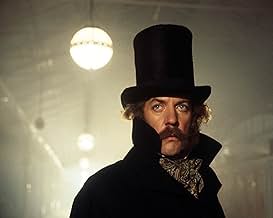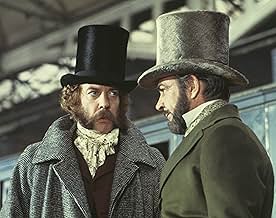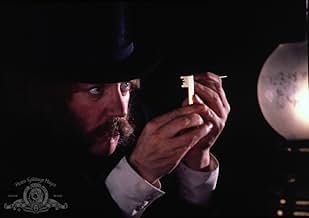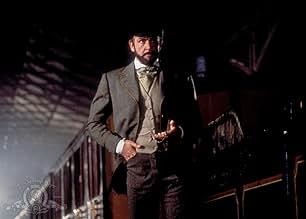Angleterre, années 1850. Un maître criminel tente de cambrioler un train transportant une grosse somme d'or. La tâche semble impossible, mais il a un plan et de bons complices pour le mettre... Tout lireAngleterre, années 1850. Un maître criminel tente de cambrioler un train transportant une grosse somme d'or. La tâche semble impossible, mais il a un plan et de bons complices pour le mettre en oeuvre.Angleterre, années 1850. Un maître criminel tente de cambrioler un train transportant une grosse somme d'or. La tâche semble impossible, mais il a un plan et de bons complices pour le mettre en oeuvre.
- Réalisation
- Scénario
- Casting principal
- Récompenses
- 1 victoire et 1 nomination au total
- John - Trent's Butler
- (as Brian De Salvo)
- Judge
- (as Andre Morell)
Avis à la une
Makes Buster look turgid - heartily recommended.
Based on a true incident , this intrigue-filled caper has been packed with suspense , thrills , action , stylish fun and hooks to keep interested . The film was entitled "The First Great Train Robbery" to distance it from a £2 million robbery from a mail train in 1963 which was known in the British press as "The Great Train Robbery" . The movie faithfully reflects some events of the Victorian era such as large differences of classes , public executions applauded by the assistants , carriage parades and many other things . Sensational trio protagonist who can steal your heart , as Sean Connery as a dashing mastermind , Donald Sutherland as a skill cracksman , and a gorgeous Lesly-Anne Down . Agreeable support cast such as Robert Lang , Michael Elphick , Alan Webb and Wayne Sleep ,one of Britain's premier ballet dancers, from The Royal Ballet Company , he actually did his own stunts, including scaling the Newgate prison walls, at the tremendous risk of falling and hurting himself . And it was the final film for both André Morell and Peter Butterworth, both of whom had died by the time that it was released . Thrilling and intriguing musical score by the great Jerry Goldsmith , director Michael Crichton frequently hired Jerry Goldsmith to compose the scores for his films . Colorful and evocative cinematography by Geoffrey Unsworth , in fact , the picture is dedicated to his memory ; being marvelously photographed against gorgeous Irish countryside . The motion picture was well directed by Michael Crichton . After giving up medicine, Michael moved to Hollywood, California, in the early 1970s and began directing movies based on his books, his first big break being ¨Westworld¨ (1973) and subsequently wrote and directed other successes as ¨Coma¨, ¨Runaway¨ and ¨13º warrior¨ until his early death by cancer at 66 years old .
This was a superb heist movie. It was clever, it was cohesive, and it was funny. I liked the pairing of Connery and Donald Sutherland. Heist movies always have to be clever and cutting edge because the mark is always super-secure and nearly impossible to breach. What sets one heist movie apart from the other is the story within and the characters. This story was straight forward and simple. There were no red herrings, no sappy side stories, and no deux ex-machinas. And the characters were very enjoyable.
This Michael Crichton film was simply excellent.
The inimitable Donald Sutherland, playing a Victorian pickpocket and con man, is somewhat miscast as Connery's partner. He is not convincingly English, to my surprise frankly, though he does bring a new characteristic or two to virtually each film he's in, and here he's not just Connery's cohort but his foil. Leslie Ann Down plays Connery's moll and co-conspirator, and she appears to have been preordained to wear Victorian undergarments.
The plot for the heist is rather upfront: The train's safe, containing the gold, is protected with four keys, each in different hands. The challenge is to divide these holders from their keys, if possible in scenarios that serious, by-the-book Victorian gentlemen would be opposed to explaining to the police, so one aged banker is shadowed at a dogfight and another is intercepted in a brothel. There's also a Stopwatch Sequence for caper enthusiasts like me: Connery and Sutherland undergo numerous trials before endeavoring to burglarize the railway company office, and we get a gracefully stage-managed robbery effort with all the timeless taps like the guard reappearing a nanosecond after the critical moment and such.
One of the foremost amusements of this drum-tight caper is the way it's determinedly in the Victorian era. The costumes and the art direction are sincere, Crichton infuses his dialogue with undoubtedly genuine Victorian gangland wording, and, for the climactic train heist, they even constructed a whole operational train. Other gratifications: The nefarious deception used to smuggle Connery into the protected car with the gold; the chase sequence atop the train; and, certainly, the loin-scorchingly superb presence of Down, who is wryly funny in her own right.
An ornately thorough and exciting caper that parades historical accuracy in support of the tempting charisma of gentleman scoundrels up to no good. Connery and Sutherland are unscrupulous to their foundations but full of audacity and shrewdness. We're supportive of them all the way, with their dashing top hats, rustling coat-tails and panorama of facial hair.
There's a patent two-act structure to the proficient script. Crichton has a scientist's sensitivity to exactitude. First the crack team toil through the preparation phases, as they progressively appropriate indentations of the four keys necessary to unlock the safe, resulting in the heist itself on a train tearing through the British scenery. In the course of this era of steam power, it appeared a hopeless scheme. Meek, perhaps, by the wicked tempo of modern action sequences, Crichton nevertheless infuses a rousing realism with Connery mannishly performing his own stunts as he traverses the rooftop through clouds of grimy smoke, for the golden fleece.
All around, Crichton absorbs the tissue and texture of whimsical Victoriana from the bitter brick walls of the prison for Wayne Sleep's lithe prison escape to the plush, glossy furnishings of the brothel where the sexy Down slips a key from Alan Webb's frenziedly horny bank manager. But naturalism is not the approach, Crichton is after a giddy attribute like it's being told as a tall story in a pub sopping in overstatement and heightened deceit to whitewash impractical snags.
Sean Connery's character has decided for himself that he will pull off what no other thief has even properly attempted to do, namely steal a large amount of government gold from a massively secured safe on a moving train. He receives help from the lewd Lesley-Ann Down, who merely just uses her feminine charms and bodily trumps, and the self-acclaimed fastest key runner in the country; Donald Sutherland. Together they must figure out how to unnoticedly get hold of four separately secured keys to the safe, and then still find a solution to break into the guarded bank wagon and get out the loot. "The Great Train Robbery" reminded me very much of "Ocean's 11". I haven't seen the 1960 original, starring Frank Sinatra, but it isn't unthinkable that Steven Soderbergh also took some ideas from this film whilst he was preparing the 2001 remake. Connery's witty charms and small talks to infiltrate into high-society families, the grotesquely detailed schemes to plagiarize the keys, the acrobatic con-artist, the meticulously timed simulations, ... These are all scenes that could come straight out of "Ocean's 11".
"The Great Train Robbery" is a well-made, nicely acted and overall reasonably entertaining period film. It does have several defaults, though, notably that Crichton cannot seem to decide whether he wants his film to be a comical crime caper or a suspenseful heist movie. Certain parts are particularly bleak (like the dog-fighting, the execution, etc...) but mostly it's tongue-in-cheek, so the film kind falls in between genres. The Robin Hood styled ending also feels very forced. The Victorian costumes and decors look great, Jerry Goldsmith's score is exhilarating and both Sean Connery and Donald Sutherland put down pleasant performances, all of which still makes "The Great Train Robbery" recommended viewing!
Le saviez-vous
- AnecdotesWriter and director Michael Crichton based his book and movie only loosely on the actual crime committed in 1855. In real-life, there were four criminals: Pierce, Agar, the railway guard Burgess and a railway clerk named Tester. All four keys were kept on railway premises, two in London, and two in Folkestone. They were stolen temporarily by Tester and Pierce, respectively, so that Agar could duplicate them, but it turned out that the Folkestone keys were not being used anyway. The guard's van was not locked from the outside; Pierce and Agar were let in by Burgess and a share of the loot was handed out to Tester at stations. None of the criminals were spotted at once; it was several months before the railway conceded that the crime must have occurred on the train. The details came to light after Agar had been convicted in an unrelated crime and his accomplices decided to steal his share instead of using it, as he had asked, to provide his mistress an income. She got word to him and he turned Queen's Evidence against the others and told all. At no point in the case did anyone escape custody.
- GaffesIf the gold shipment was solely to pay British soldiers in Crimea, as asserted, it would have been in the form of barrels of gold coins, not gold bars as shown.
- Citations
Judge: [Judgementally] Now, on the matter of motive, we ask you: Why did you conceive, plan and execute this dastardly and scandalous crime?
Edward Pierce: I wanted the money.
[the court spectators roar with laughter]
- Crédits fousCóras Iompair Éireann is misspelled in the end titles with an accent over the 'C' instead of the 'o'.
- Versions alternativesUnder the terms of the Cinematograph Films (Animals) Act 1937 all UK versions of the film are cut by 32 secs with edits to a scene where a dog hunts and kills rats in a show arena ('ratting').
- Bandes originalesI Dreamt I Dwelt in Marble Halls
(uncredited)
Music by Michael William Balfe
Lyrics by Alfred Bunn (1843)
Heard on violin offstage in bordello
Meilleurs choix
Everything New on Prime Video in July
Everything New on Prime Video in July
- How long is The Great Train Robbery?Alimenté par Alexa
- What is 'The Great Train Robbery' about?
- Is "The First Great Train Robbery" based on a book?
- Where is Crimea?
Détails
- Date de sortie
- Pays d’origine
- Langues
- Aussi connu sous le nom de
- El gran asalto al tren
- Lieux de tournage
- Cork Kent station, Glanmire Road, Cork, County Cork, Irlande(Brighton station)
- Sociétés de production
- Voir plus de crédits d'entreprise sur IMDbPro
Box-office
- Budget
- 6 000 000 $US (estimé)
- Montant brut aux États-Unis et au Canada
- 13 027 857 $US
- Week-end de sortie aux États-Unis et au Canada
- 391 942 $US
- 4 févr. 1979
- Montant brut mondial
- 13 027 857 $US
- Durée1 heure 50 minutes
- Couleur
- Rapport de forme
- 1.85 : 1
Contribuer à cette page




































